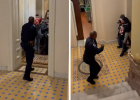- Joined
- Sep 5, 2019
- Messages
- 77
Fuck, empirical evidence as to why I'm the best person at partiesExactly! And you see this play out in other social settings, too.
It's the rioting equivalent to being the first person to bust a move on the dance floor after the music has started.

